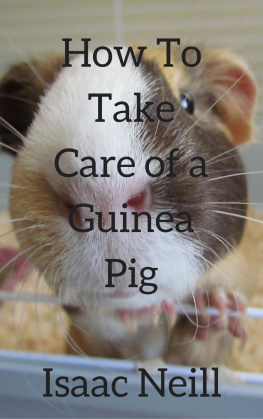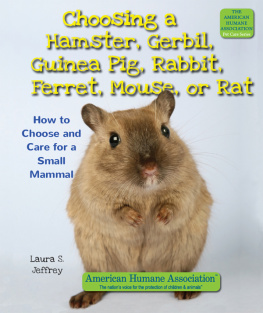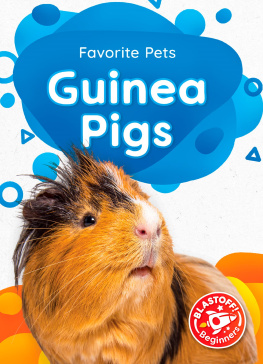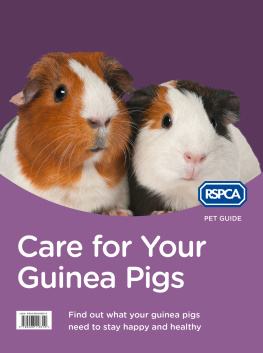Isaac Neill - How to Take Care of a Guinea Pig
Here you can read online Isaac Neill - How to Take Care of a Guinea Pig full text of the book (entire story) in english for free. Download pdf and epub, get meaning, cover and reviews about this ebook. year: 2015, publisher: Isaac Neill, genre: Children. Description of the work, (preface) as well as reviews are available. Best literature library LitArk.com created for fans of good reading and offers a wide selection of genres:
Romance novel
Science fiction
Adventure
Detective
Science
History
Home and family
Prose
Art
Politics
Computer
Non-fiction
Religion
Business
Children
Humor
Choose a favorite category and find really read worthwhile books. Enjoy immersion in the world of imagination, feel the emotions of the characters or learn something new for yourself, make an fascinating discovery.
- Book:How to Take Care of a Guinea Pig
- Author:
- Publisher:Isaac Neill
- Genre:
- Year:2015
- Rating:5 / 5
- Favourites:Add to favourites
- Your mark:
- 100
- 1
- 2
- 3
- 4
- 5
How to Take Care of a Guinea Pig: summary, description and annotation
We offer to read an annotation, description, summary or preface (depends on what the author of the book "How to Take Care of a Guinea Pig" wrote himself). If you haven't found the necessary information about the book — write in the comments, we will try to find it.
This book informs you about guinea pigs, and how to take care of them.
How to Take Care of a Guinea Pig — read online for free the complete book (whole text) full work
Below is the text of the book, divided by pages. System saving the place of the last page read, allows you to conveniently read the book "How to Take Care of a Guinea Pig" online for free, without having to search again every time where you left off. Put a bookmark, and you can go to the page where you finished reading at any time.
Font size:
Interval:
Bookmark:
How to Take Care of a Guinea Pig
Isaac Neill
Published by Isaac Neill, 2015.
While every precaution has been taken in the preparation of this book, the publisher assumes no responsibility for errors or omissions, or for damages resulting from the use of the information contained herein.
HOW TO TAKE CARE OF A GUINEA PIG
First edition. May 5, 2015.
Copyright 2015 Isaac Neill.
ISBN: 978-1513068510
Written by Isaac Neill.
10 9 8 7 6 5 4 3 2 1
This book is dedicated to my guinea pig Rocket.
G uinea Pigs (also called Cavia porcellus cavies as there scientific name) are rodents belonging to the family Caviidae and the genus Cavia. Even though their common name is guinea pig, these animals are not pigs, and do not come from Guinea. Male guinea pigs are called boars , females are called sows and guinea pig babies are called pups . They were originally native to the Andes, and while they are no longer extant in the wild, they are closely related to several species which are most commonly found in the grassy plains and plateaus of this region. In the Western societies, the guinea pig has enjoyed widespread popularity as a household pet since its introduction by a European trader in the sixteenth century. Because of how docile it is and, how easy they are to take care of. Also how responsive it is to handling and feeding, the guinea pig still remains a popular pet choice. Organizations have devoted to competitive breeding of guinea pigs have been formed worldwide, and a large number of specialized breeds of guinea pig, with varying coat colors and compositions, are cultivated by breeders.
T ake care in choosing your guinea pig and its possible companions is the first, and possibly the most important, step in keeping guinea pigs as pets. Make sure your guinea pigs are either of the same gender or they are fixed. When choosing a guinea pig you do not want to get one if it has a runny nose or if its eyes are watering. Those are signs that the guinea pig is sick or unhealthy or it could an upper respiratory infection, or URI, and can be deadly if left untreated.
(E specially in pet stores) are the short-haired "American" or the "Self" breed and the "Abyssinian", which has curly, cow-licked hair. Long-haired guinea pigs (the Sheltie/Silky and Peruvian breeds) can be very pretty pets, but they also need to have a daily grooming to stay healthy, that can make them not suitable for children. The hair near the rear of the guinea pig must be cut and cleaned on a regular basis, or it will get caked with feces and the bedding from the cage. Short hair guinea pigs take less effort in the hygienic and cosmetic categories, but should still be properly cared for. That means, the Peruvian guinea pig breed is the most difficult breed to care for due to the long hair. It gets tangled extremely easily, and is not recommended for anyone without extensive time to care for the cavy's hair every day.
W ith a big majority in rescues, smart vets, household guinea pig breeders and scientists will tell you that guinea pigs should be housed in groups of two or more. Not only is making sure your guinea pigs have companions important for their health and happiness, keeping multiple guinea pigs will improve the fun of having these animals as pets as you watch them interact. One of the best options is usually a pair of the same gender guinea pigs out of the same family or breed and, of course the most important factor in choosing groups is to make sure you will not have any unwanted babies, so make sure your pets are either of the same gender or fixed. While groups of boars or guinea pigs might get along (provided no females are present and they are carefully introduced), and groups of females are often fine, the easiest combination is one fixed guinea pig and one or more females. Often the personality of individual guinea pigs varies; with some being very happy to have company and others not happy to have company or showing anything but hostility to other cavies.
G uinea pigs are normally very gentle, and even untamed guinea pigs will not bite you unless you are causing them pain or they have been abused in the past. Guinea pigs also have a poor sense of sight, but well-developed senses of hearing and smell. Vocalization is the primary means of communication between members of the species.
W hile their are some older guinea pig resources may say that housing them outdoors is acceptable, that is just not good for them so do not place your guinea pig in a cage outside. They are reasons why you should not place the cage outside. Wind can blow a hutch over easily and it is also the perfect place for mold spores to grow. Spiders and insects can bite guinea pigs that are left outside. There is no guarantee that temperatures outside will be acceptable for your guinea pig to live in. It is very hard to notice signs of disease in guinea pigs if they are constantly out of sight, and out of your mind. Even indoors, sudden drafts or radical shifts in temperature may adversely affect the health of your guinea pig. Outdoors, guinea pigs may still be subject to predators such as raccoons, opossums, birds of prey and cats. Even a guinea pig physically protected from a predator may suffer from the ill effects of stress from the presence of a predator. Guinea pigs in the Andean region of South America are often kept outside on roofs or in milk crates. But these are livestock, not pets. A pet guinea pig is a member of your family and will benefit from the most interaction available. Being inside your home will make it easier and more appealing to care for and play with your guinea pig. Additionally, most secure hutches are designed for rabbits, and as such have mostly wood or wire floors that are unsuitable for guinea pigs. These wire floors are extremely painful for rabbits and cavies alike, and will damage their delicate feet. Also Indoor housing should consist of a large cage, with a plastic base (not metal mesh, this can damage the guinea pig's feet and the can wood will soak up urine permanently. As guinea pigs are not climbers, a top is only absolutely necessary if other pets are present in the house. A pet store cage is nowhere near adequate size for a happy guinea pig, and will cost in upwards of $80-120. The minimum size cage for 1-2 guinea pigs is 7.5 square feet but I would recommend a cage with about 13.5 square feet. The housing of the guinea pigs cage should be lined with bedding at a minimum of 1 inch deep, ideally deeper in the sleeping areas. You should never use softwoods such as pine or cedar shavings for bedding, as these emit harmful odors called phenols that cause your guinea pig respiratory problems. Hardwoods such as aspen are fine. Other options for bedding are recycled paper products such as Carefresh these are more expensive, but also stay clean for longer than shavings and are easier on a guinea pig's feet. A cage needs to be cleaned generally every week at the very minimum, but more often as needed.
A re a gravity-fed water bottle, a small bowl for pellets and other food, and "hidey houses". Wild cavy species and feral guinea pigs naturally use dens made by other animals, and all domestic guinea pigs should be provided a safe place to hide in. As they are prey animals, they will feel much more secure in their environments if they have places to hide. This can be a plastic "igloo" or wood house from a pet store, or simply a towel tent. Be aware that some cardboard is put together using glues that can be harmful to your guinea pig, so it is best to avoid these if you can. If you have more than one guinea pig, having both an entrance and an exit to any hiding places can prevent fights between cornered guinea pigs. The more hiding places, the merrier! It is also better for your guinea pigs to keep borders around the cage clear, so that they can run laps.
Font size:
Interval:
Bookmark:
Similar books «How to Take Care of a Guinea Pig»
Look at similar books to How to Take Care of a Guinea Pig. We have selected literature similar in name and meaning in the hope of providing readers with more options to find new, interesting, not yet read works.
Discussion, reviews of the book How to Take Care of a Guinea Pig and just readers' own opinions. Leave your comments, write what you think about the work, its meaning or the main characters. Specify what exactly you liked and what you didn't like, and why you think so.












